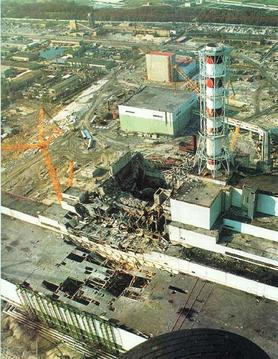Good morning, Whitewater.
Sunday in the Whippet City will be pretty, with a high of fifty-nine and sunny skies. Sunrise is 5:54 and sunset 7:50, for 13h 55m 04s of daytime. The moon is a waxing gibbous with 54.8% of its visible disk illuminated.
Recent weather events color our perception of trends, and television hysteria over single events does, too:
Today is the anniversary, from 1986, of the Chernobyl Disaster:
The Chernobyl disaster … Chornobylska Katastrofa – Chornobyl Catastrophe; also referred to as Chernobyl or the Chornobyl accident) was a catastrophic nuclear accident that occurred on 26 April 1986 at the Chernobyl Nuclear Power Plant in Ukraine (then officially the Ukrainian SSR), which was under the direct jurisdiction of the central authorities of the Soviet Union. An explosion and fire released large quantities of radioactive particles into the atmosphere, which spread over much of the western USSR and Europe.
The Chernobyl disaster was the worst nuclear power plant accident in history in terms of cost and casualties.[1] It is one of only two classified as a level 7 event (the maximum classification) on the International Nuclear Event Scale, the other being the Fukushima Daiichi nuclear disaster in 2011.[2] The battle to contain the contamination and avert a greater catastrophe ultimately involved over 500,000 workers and cost an estimated 18 billion rubles.[3] During the accident itself, 31 people died, and long-term effects such as cancers are still being investigated….
The disaster began during a systems test on Saturday, 26 April 1986 at reactor number four of the Chernobyl plant, which is near the city of Pripyat and in proximity to the administrative border with Belarus and the Dnieper River. There was a sudden and unexpected power surge, and when an emergency shutdown was attempted, an exponentially larger spike in power output occurred, which led to a reactor vessel rupture and a series of steam explosions. These events exposed the graphite moderator of the reactor to air, causing it to ignite.[4] The resulting fire sent a plume of highly radioactive fallout into the atmosphere and over an extensive geographical area, including Pripyat. The plume drifted over large parts of the western Soviet Union and Europe. From 1986 to 2000, 350,400 people were evacuated and resettled from the most severely contaminated areas of Belarus, Russia, and Ukraine.[5][6] According to official post-Soviet data,[7][8] about 60% of the fallout landed in Belarus.

